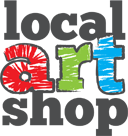Soft Pastels
What are pastels?
Pastels are compressed pigment and binder formed into sticks. The higher quality the pastel the greater the pigment, which increases the coverage and intensity of the colour.
Types of pastel
Soft pastels
These are as the name suggests a soft stick of pigment and binder, the artist level tend to have a crumbly texture and usually a high concentration of pigment to binder ratio giving an intense colour. The consistency of the pastels makes them ideal for blending and layering. They come in either half or full sticks and can range in thickness.
Carré (Square) pastels
These are still a soft pastel, but may be referred to as hard pastels, this is due to the fact that they are harder and therefore less brittle than soft pastels. They contain the same raw materials but with higher levels of binder, this reduces the amount of dust produced and makes them ideal for sketching. The square shape allows for large coverage of area as you can use the flat side, or you can shape the ends as required.
Pastel pencils
These are soft pastel encased in wood giving them a great versatility, as they can be easily sharpened to a point for fine detailing or use a blunter tip for a softer look.
Soft, carré and pastel pencils can all be used and blended together.

Surface
What type should I use?
Due to the consistency of pastels they need a ‘tooth’ (a rough texture) in order to adhere to the surface, as this texture removes the pigment from the stick.
If you want to build up layers of colour you will need a rougher surface as there will still be tooth for the pastel to grip as you add your layers.
For blending colours you should use a softer surface as a rough tooth can interfere with the blending of colours.
When choosing you surface you should think about what you want the final result to look like. While a less rough surface can mean you have less layers of colour the finished creation will have a smoother finish. While a rougher surface can add texture to your finished work.
Papers
When using paper for pastels you need to consider the texture of the paper, as it not only needs the tooth in order to transfer to colour but must also be able to withstand blending, erasing and rubbing that is generally used with pastels.
Pastel papers are textured, they are generally made with either a percentage of ‘rag paper’ which is cotton or cellulose giving the paper extra strength. High quality pastel papers can come in different tones and textures, ranging from a soft velour to a sanded texture or a stiff textured board.
Toned paper can allow you to contrast or harmonise with your chosen colours to help add atmosphere and effect to your artwork. Darker toned paper will highlight and enhance light coloured pastels and lighter toned paper will emphasise dark colours.
Watercolour paper can also be used for pastels as it designed to be strong and also comes in a range of textures and can be found in some light tinted colours.

Tools
Pastel shapers
These have handles like a paintbrush but have a rubbery end rather than hairs. Like brushes they come in different shapes and sizes, a round pointed shaper is ideal for fine detailing, whereas the chiselled shapes will add more expressive strokes and blend larger areas.
Brushes
Some artists utilise brushes to apply the pigment. Brushes can also be used for blending and softening or removal of colour or removal of unwanted surface powder.
Tortillions
Also called blending stumps are made of soft rolled paper with pointed ends. The fine tips can be useful for blending or removing colour in small areas. The broader tips can be utilised over larger areas. As they are made from paper they can be ‘sharpened’ using sandpaper as they wear down. Again they come in varying thicknesses in our current range there is ¼” up to ½”.
Kneaded rubber
These soft mould-able erasers allow for precision blending as you can shape them to the desired size and shape.
Of course you can always use your fingers for blending and smudging, however be careful to keep your hands clean so you don’t accidentally transfer colours or created unwanted smudges.
Fixative
Fixative helps bind the top layer to the surface creating an invisible protective layer. This protects the pigment from rubbing off, smudging or crumbling.
A unfragranced hairspray can be used as a fixative when you are learning but we would recommend using actual fixative when possible.
The use of fixative will be a personal preference as while it does protect your artwork it can mean that you lose some of the texture when used on the final layer.
Recommended products
Soft pastels
For beginners we would recommend looking at the Van Gogh range of soft pastels as they offer a student level quality without a massive initial cost. Another option would be to try Derwent pastel pencils as they have the feel of pastels but give more control and less mess.
For the more advanced artist we would recommend either Sennelier or Rembrandt as they are beautiful artist level pastels and can be purchase in beautiful cases for an extra indulgence.
Papers
For beginners we would recommend Canson Mi-Teintes as there are protective layer between the sheets and the honeycomb surface holds pigment and allows for layering.
As you advance Clairefontaine Pastelmat Pad, which is a stiffer more sturdy like pad, Sennelier La Carte Pastel Pad with its soft sand like surface or Hahnemühle Velour which has a soft velvet like texture or move onto larger or the tinted Canson Mi-Teintes.

